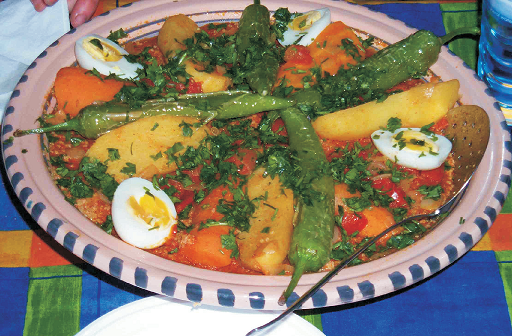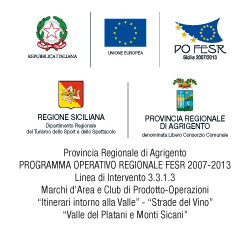Visiting Agrigento also means savoring the typical "giurgintane dishes ", with all the gastronomic delicacies that the magical land offers.
Arriving in the city of temples, you will find in its daily meals, a mix of flavors that will enchant you like the sensual embrace of a beautiful Sicilian woman.
From appetizers to dessert, it is a bag of goodies that will oblige a tourist, on his return from holiday, to go on a diet to get back into shape.
One can assume that in any bakery in the city, all the succulent delicacies displayed in the windows are handcrafted, daily breakfast becomes a real conundrum of what to choose and taste first.
If one of the Sicilian sweets had the title of queen, it would be given to the cassata. You can start your day relishing a slice, luxuriously filled with ricotta cream or, if you want, you can taste the king of the Sicilian sweets: his majesty the "cannoli". Or why not try "cciarduni", a typical Agrigento sweet stuffed with ricotta cream and covered with sprinkles of chopped almonds? Or maybe a nice piece of rustic pie with ricotta and "giurgintane" almonds as well.
If you love drier sweets that are not very creamy, then we recommend choosing pastries stuffed with almonds or pistachio.
In the fall, during the commemoration of the dead, you will find an explosion of colorful "MARTURANA fruits", or white "carcagnetti" also called eerily "bones of the dead." And if your visit to the City of Temples coincides with the Easter period, then we recommend to taste the royal lamb pastry with its soul of pistachio paste. It's a delight as it is exclusively handmade with the use of almonds and pistachios from crops in the province of Agrigento.
Local almonds are always in "cubaita", Sicilian torrone, "ricci" biscuits, marzipan fruit, and almond cakes, which are just some of the delicacies that we immediately suggest trying to anyone visiting Agrigento. Should you wish to enjoy something unusual, then we suggest the "mastazzola" (cookies made from dough that is kneaded and softened with mulled wine and black pepper). They are a real treat that we recommend washed down with zibibbo wine.
Encouraged by a very mild Agrigento climate, you can get good ice cream even in the winter. And, if your vacation takes place during the summer, every day you can enjoy a different flavor. In Agrigento, as well as at the seaside beach of San Leone, you can find plenty of opportunities to fulfill your desire for ice-cream. From simple, soft cones to stuffed croissants, you can enjoy uniquely flavoured ice cream.
Arriving at lunch hour, from 1 p.m. on, you can recharge by choosing to visit one of the many restaurants in the city, ready to treat you to traditional local fish and meat specialties.
Here are some of the dishes that are usually served in the restaurants of Agrigento, starting from vegetable or fish appetizers:
The knowledgeable use of vegetables, fruits of the traditional farmer, produce some delicacies that in their simplicity express strong, decisive and intense flavors, with the support of a generous amount of Agrigento extra virgin olive oil and local herbs and spices.
Generally presented as a "rustic appetizer", "chiappe" are served (red tomato dried outside in the summer and put in oil) with tomatoes, fried eggplant, artichokes under oil, artichoke caponata, eggplant caponata, "olivi scacciati" (crushed, seasoned olives), "passuluna" (baked black olives), chickpea fritters and potato croquettes. And omelettes made with artichokes, eggplant or zucchini. A real pleasure.
Even the fish occupies a very important role among appetizers. Always fresh from the coast is an excellent seafood salad with octopus, shrimp, mussels and clams or even raw marinated shrimp, breaded swordfish, or genuine blue fish like sardines that are simply prepared "beccafico" style with bread crumbs, spices, pine nuts and raisins - an irresistible dish.
Every restaurant, in addition to offering a wide choice of first courses, generally presents a typical specialty that is none other than the product of Sicilian culinary creativity.
Nevertheless, we recommend some of the traditional first courses such as pasta with sardines, rigatoni with sauce and sausage or with cauliflower, pine nuts and raisins, or with the broccoli (in dialect "giurgintano", called "pasta cu sparaceddu") recommended with grated pecorino, the fresh giurgintana cavatelli pasta, topped with fresh tomato sauce, fried eggplant and basil, covered with salted ricotta, or the spaghetti "carrettiera" or dressed with green tomatoes, or ditalini with beans and fresh ricotta cheese and pistachio macaroni or the legendary baked pasta that some people call a timbale of pasta, made with rigatoni or anellini. An explosion of Sicilian flavors in which the protagonists are the bolognaise sauce prepared with fresh tomatoes and lean minced meat, pecorino or caciocavallo cheese, hard-boiled eggs, breadcrumbs with fried or roasted eggplant. Generally, after a generous portion it is difficult to eat a main course.
Fish plays an important role in the preparation of dressings and sauces for pasta dishes: spaghetti with lobster sauce, asparagus and shrimp or shellfish, or fettuccine with shrimp scampi, and risotto with artichokes and shrimp are just some suggetions of what you can enjoy.
Before concluding with the first dish, it is only right to mention the soups and stews.
Among soups, undoubtedly "u maccu" excels. The dish originating in the country Raffadali is a cream of beans to which one must add pasta. There is also the very simple, but tasty soup, "cabbage" and lentils.
Moving on to the main courses, meat deserves a separate discussion. It ranges from the rich barbecue grill with grilled lamb chops, pork and veal and the unforgettable sausage seasoned with hot pepper, sesame and fennel.
There's the rabbit "all'agru-duci" (sweet and sour) cooked stew with celery, olives, onion, garlic and spices, or the roast goat with potatoes and onion, or even Sicilian style rolls with bread crumbs, cheese, pine nuts, raisins or fillet with orange juice and so many other specialties that you can enjoy during your visit to Agrigento restaurants.
In some restaurants you can find, on fixed days, typical dishes that you should try. One of these is "roba cotta". It is a dish consisting of various dishes like the boiled innards of veal and lamb seasoned with olive oil and lemon. Generally a dish will include tripe, "u zirenu", "u pedi porcu" (boiled pig's foot) and "u sancunazzu" (blood sausage), prepared with veal blood cooked with plenty of pepper and spices.
Moving on to second dishes, fish, all restaurants will provide only local fish caught on the coast in front of the province. Therefore, you are spoiled for choice whether you prefer it grilled or stewed.
Speaking of fish, one is required to say the word "couscous", but it is equally essential to say it when it comes to sweets from Agrigento.
In fact, the local cuisine has a case, perhaps unique in the world, where two culinary specialties have the same name for two completely different types of dishes.
Historically "couscous" finds its origins in Arabic cuisine and the predominant ingredient is mutton, topped with very spicy tomato sauce, meal, chili, potatoes, and various herbs. In Sicily, however this dish, arrived with the invasion of the Arabs, and as a variant, the delicious fish of our coasts replaced the meat, which underwent, subsequent to Agrigento, a total metamorphosis turning into a delicious dessert prepared by the nuns of the monastery of Santo Spirito. According to an old secret recipe, the basic ingredients are almonds and pistachios.
At this point the question arises: which is better, the fish or the sweets? The only remedy to solve this puzzle is to try both versions, remembering to wash fish cous-cous down with one of the many white wines or the sweet almond and pistachio couscous with an excellent "Zibibbo" or "Inzolia".
In the event that you are looking for a restaurant alternative, you might want to enjoy the many delicacies from the "tavola calda".
You could start with rice balls with meat and mozzarella, "rizzuole", "ravazzate" or the pasta sheet pastries seasoned with the meat and peas sauce.
Then there are the calzones, baked or fried, stuffed with mozzarella and ham, or the "mmiscate" made with bread dough kneaded and softened with lard, stuffed with cheese, sausage and olives, or olives, sausage and cheese or even cauliflower with onion and cheese.
In the varied world of delicacies that belong to the family of the pizza, we must distinguish the traditional pizza, usually proposed and served in the pizzeria, and the typical local pizza, which can be found in bakeries and caterers, served by the slice.
Of the latter there are several typically Agrigento varieties like the pizza of San Calo and "u sfingiuni" eu "Cudduruni".
These in turn are divided into a sort of subcategory according to the stuffing and the filling. "U sfingiuni" could be the "Palermitana" version with tomato, onion, primosale cheese and diced pieces of anchovies, or with potatoes, tomato, onion, cheese, or "carrittera" with garlic, sardines, cheese, oregano and in many other ways that we suggest you to see it directly on site.
"U Cudduruni" consists of two layers of dough in which there is a filling or vegetables or minced meat with various cheeses, and tomato, peas, onion and various spices, or ricotta cheese, ham and spinach. In this case we suggest seeing it directly on site.
The recipe (for 4 persons)
Cavatelli pasta with fresh giurgintana
Ingredients: - For the cavatelli dough: 500 grams of flour - 2 eggplants - 1 kg. tomato pulp- grated cheese - basil - red pepper - onion - extra virgin olive oil - salt
Knead the dough and let it rest for 15 minutes. Take the dough and form shapes like snakes, cutting small pieces about 2 cm long and on a wood surface roll and curve them with your fingers; let them dry on a towel.
Cut the eggplant into cubes or strips and fry. Saute the onion, add the tomato pulp.
When the pulp is cooked, turn off the heat and add the fried eggplant, after eliminating the excess oil.
Cook the cavatelli al dente and transfet it to a buttered casserole dish. Drizzle it with the sauce, add the basil leaves and cheese, stir and bake at 200 degrees for 15-20 minutes.



